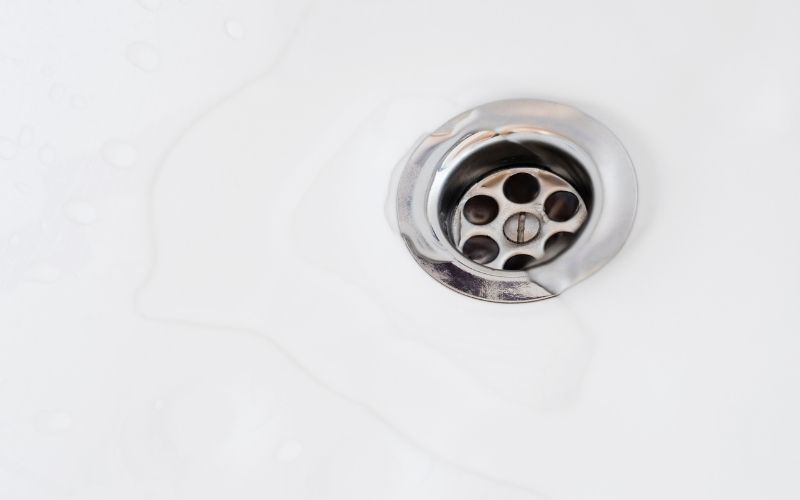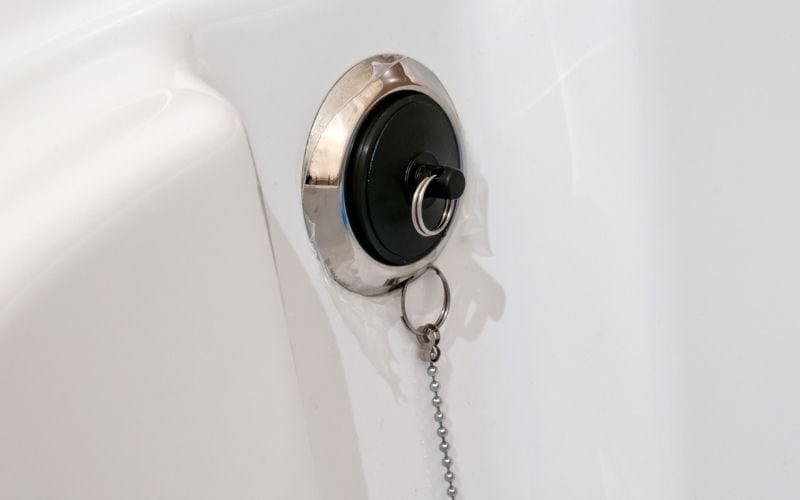Bathtub plugs are an easy way to seal your tub and hold water in, but they’re not the only way!
If you’re having issues because your plug is missing, broken, or not sealing, no worries, there are still ways to stop that water from going down the drain.

And the best part is you may be able to find several of these alternative items around your house already!
How Do You Close a Bathtub Drain Without a Stopper?
To start, you’ll need to locate the drain in your tub. Once you’ve found it, take a look at the size and shape.
This will give you an idea of what kind of item you’ll need to seal the drain. Next, use one of the following methods to block your bathtub drain:
Use a Cup or Bowl
Use a cup, bowl, or pot that’s close to the size of the drain. Place it over the drain and press down firmly. If you have a smaller drain, you may need to use something like a measuring cup or ramekin.
Use Plumber’s Putty
If you can’t find anything to use as a makeshift stopper, try using Plumber’s Putty. This is a common product used by professionals to seal drains and leaks, so it should do the trick!
In order to use this method, roll pieces of the putty out into long cylinders and spiral the material in a circle around the drain and the broken stopper.
This will create a firm barrier, but keep in mind that it will need to be replaced each time you use the tub and therefore, it is a very temporary solution.
Form a Ball out of Towels
This one may take some trial and error, but it’s worth a shot.
Wet a few towels and ring them out so they’re damp but not dripping. Next, form the towels into a ball that’s slightly smaller than the drain.
Press the towel ball down into the drain and hold it in place until it forms a seal. You may need to adjust the size of your towel ball or use more than one to get a good seal.
Use a Plastic Bag Filled with Water
This is a similar method to using a cup or bowl, but it may give you a better seal.
Fill a plastic bag (gallon-sized will work great) with water and seal it. Then you can place it over the drain. Use your other hand to press down around the edges of the plastic bag to create suction.
You can also put a washcloth or another type of fabric into the ziplock bag so that it’s a bit heavier and will create a stronger seal on the drain area.
Reuse an Empty Coffee Coffee Pod
If you have an empty coffee pod, you can use that to block your bathtub drain! Just place it over the drain and press down.
The coffee pod will create a seal and hold the water in. If it’s too small to place in the drain, grab a rubber band or two and wrap them around the cup to expand its circumference.
This pop-up drain makes a great DIY bath plug because there are only 1 to 2 steps for you to follow.
Use a Toilet Bowel Plunger
A toilet plunger can also be used to block a bathtub drain. Just make sure that the plunger is big enough to cover the entire drain.
Clean your plunger and then place it over the drain. Use your other hand to press down around the edges of the plunger to create suction.
Once it has adhered, you can remove the handle if it easily screws off. If the wooden handle goes through your plunger and there is a hole in it, you’ll need to leave it in to maintain the suction.
Use Waterproof Tape
If you have waterproof duct tape, you can use that to seal the bathtub drain. Just place the tape over the drain hole and press down. The tape will create a barrier and hold the water in.
As an alternative, you can also try using regular duct tape or gaffer tape. These are both strong tapes that will create a seal, but they may not be as waterproof as other options.
Keep in mind, especially with heavy-duty tape, that you’ll need to use a utility knife or scissors to cut through the tape when you’re ready to drain the tub, as well as scrape off some residue.
You can use vinegar to help remove any leftover adhesive.
Use a Marine Drain Twist Plug
If you happen to enjoy fishing or boating, you may have one of these plugs lying around.
They are used to keeping water in boat drains from coming back up, so they’ll work just as well for your bathtub! You may have one in your fishing kit or tackle box.
To use this method, simply twist the plug into the drain. The rubber will create a seal and hold the water in. You can remove it when you’re ready to drain the tub by simply twisting it out.
Use a Plastic Lid or Jar Lid
You can use a plastic or jar lid to block your bathtub drain. Just make sure that the lid is big enough to cover the entire drain.
First, find a flat jam jar lid in your kitchen. Then clean the lid and then place it over the drain. Use your other hand to press down around the edges of the lid to create suction.
The jar lid will create a seal and hold the water in. You can remove it when you’re ready to drain the tub by simply lifting it off.
Use a Rubber Plug

If you’re not ready to replace your entire bathtub drain hole at this point, you can purchase a silicone or rubber stopper to place over the drain hole.
These come in a variety of sizes, so make sure you measure your drain before purchasing one.
To use this method, simply place the drain stopper over the hole and press down. The rubber or silicone will create a seal and hold the water in. You can remove it when you’re done by using its easy-to-pull handle.
You can find these in your local hardware store or online. It’s the easiest replacement for a bathtub plug and you can use it several times before replacing the original bathtub drain plug.
Do You Need a Drain Stopper?

You may be wondering if you even need a drain stopper. After all, most bathtubs have a built-in stopper that you can use to plug the drain.
This depends on a few factors. If you never take baths in your tub or you have a shower without a plug, then you probably don’t need one.
However, it can be nice to be able to fill your tub up to perform your household tasks such as cleaning or laundry without having to worry about the water draining out.
If you don’t have a stopper in your drain hole, it may also leave it open, which means that objects such as jewelry or hair can fall through. You may want to consider getting a hair catcher so nothing will block a bathtub drain.
If you don’t want a permanent stopper, many of these alternatives will work fine in a pinch. This way, you can fill up your tub for special projects or emergencies.
Why Does My Tub Not Hold Water?
If your tub doesn’t seem to be holding water, there are a few things you can check. First, make sure that the drain is plugged. If it’s not, then water will obviously be able to escape through the hole.
Check the overflow drain as well. This is usually located near the faucet on your tub. If your tub is filled above this point, water will begin to drain through it.
If you have a bathtub with jets, there may be a small hole in the jet that drains water out. Make sure this hole is plugged as well.
If you have a faulty overflow tube in your bathtub, it will also cause water to drain out. You can try to replace the overflow tube yourself or you may need to call a plumber to do it for you.
If your bathtub is still not holding water, there may be a bigger problem such as a crack in the tub itself. If this is the case, you’ll need
It’s also possible that your drain hole has worn away and is no longer able to create a strong seal. In this case, you’ll need to replace your tub drain entirely.
If you’re not sure how to do this, you can always call a professional. They’ll be able to help you figure out what’s going on and get your tub back in working order.
You can also look up the manufacturer of your tub which can help you to find a tutorial or video on how to replace your tub drain.
How Does a Pop-up Tub Drain Work?

A pop-up tub drain is the most common type of tub drain. It’s a simple design that consists of a plug that fits into the drain hole.
You can operate the pop-up drain by pressing down on the center of it and slightly twisting it to lock it into place.
This will cause the plug to rise and allow water to flow out. To open it, simply press down on the center again and twist it in the opposite direction.
This type of drain is easy to use and you likely won’t have any problems with it.
However, if it does start to malfunction, you may have to remove the metal plug in order to use many of the above options for a makeshift drain stopper.
Final Thoughts
How to block a bathtub drain without a plug? Now the answer to this question is easy breezy since you’ve read this helpful guide!
With so many options, you’re sure to find a method that works for you!
Be careful not to use anything that could damage your bathtub drain hole as you may need to replace it eventually. If you have any questions, feel free to ask a professional.
Related:
